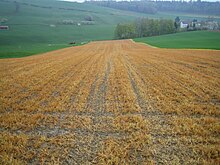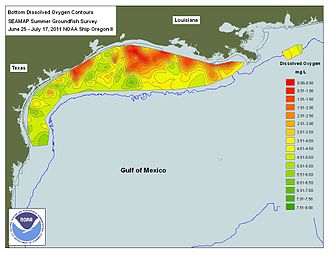Agricultural chemistry: Difference between revisions
No edit summary |
m Added internal links |
||
| (32 intermediate revisions by 6 users not shown) | |||
| Line 1: | Line 1: | ||
{{Short description|Agricultural sub-discipline of applied chemistry}} |
{{Short description|Agricultural sub-discipline of applied chemistry}} |
||
[[File:2,4-Dichlorophenoxyacetic acid structure.svg|thumb|[[2,4-D]], an early synthetic herbicide inspired by the study of [[auxin]]s, had a profound impact on crop yields, starting in the 1940s.]] |
|||
'''Agricultural chemistry''' is the study of [[chemistry]], especially [[organic chemistry]] and [[biochemistry]], as they relate to [[agriculture]]. This includes agricultural [[Production (economics)|production]], the use of ammonia in fertilizer, pesticides, and how plant biochemistry can be used to genetically alter crops. Agricultural chemistry is not a distinct discipline, but a common thread that ties together [[genetics]], [[physiology]], [[microbiology]], [[entomology]], and numerous other sciences that impinge on agriculture. |
|||
| ⚫ | '''Agricultural chemistry''' is the [[chemistry]], especially [[organic chemistry]] and [[biochemistry]], as they relate to [[agriculture]]. Agricultural chemistry embraces the structures and chemical reactions relevant in the production, protection, and use of [[Crop|crops]] and [[livestock]]. Its [[applied science]] and [[technology]] aspects are directed towards increasing yields and improving quality, which comes with multiple advantages and disadvantages.<ref>{{cite web |title=Scope, Journal of Agricultural Chemistry |url=https://publish.acs.org/publish/author_guidelines?coden=jafcau}}</ref> |
||
==Agricultural and environmental chemistry== |
|||
| ⚫ | Agricultural chemistry |
||
This aspect of agricultural chemistry deals with the role of molecular chemistry in agriculture as well as the negative consequences. |
|||
| ⚫ | |||
==Advantages and Disadvantages== |
|||
[[Plant biochemistry]] encompasses the chemical reactions that occur within plants. In principle, knowledge at a molecular level informs technologies for providing food. Particular focus is on the biochemical differences between plants and other organisms as well as the differences within the plant kingdom, such as [[dicotyledon]]s vs [[monocotyledon]]s, [[gymnosperm]]s vs [[angiosperm]]s, C2- vs [[C4 carbon fixation|C4-fixer]]s, etc. |
|||
| ⚫ | |||
The goals of agricultural chemistry are to expand understanding of the causes and effects of biochemical reactions related to plant and animal growth, to reveal opportunities for controlling those reactions, and to develop chemical products that will provide the desired assistance or control. Agricultural chemistry is therefore used in [[Food processing|processing of raw products into foods and beverages]], as well as environmental [[Environmental monitoring|monitoring]] and [[Environmental remediation|remediation]]. It is also used to make feed supplements for animals, as well as medicinal compounds for the prevention or control of [[disease]]. When agriculture is considered with [[ecology]], the [[sustainablility]] of an operation is considered. |
|||
[[File:Direktsaat Probleme001.JPG|thumb|A field after application of a herbicide]] |
|||
| ⚫ | Chemical materials developed to assist in the production of food, feed, and fiber include [[Herbicide|herbicides]], [[Insecticide|insecticides]], [[Fungicide|fungicides]],<ref>{{cite book |doi=10.1002/0471238961.0621140704180509.a01 |chapter=Fungicides, Agricultural |title=Kirk-Othmer Encyclopedia of Chemical Technology |date=2000 |last1=Dreikorn |first1=Barry A. |last2=Owen |first2=W. John |isbn=978-0-471-48494-3 }}</ref> and other [[Pesticide|pesticides]]. Pesticides are chemicals that play an important role in increasing crop yield and mitigating crop losses.<ref>{{cite journal |last1=al-Saleh |first1=I. A. |title=Pesticides: a review article |journal=Journal of Environmental Pathology, Toxicology and Oncology |date=1994 |volume=13 |issue=3 |pages=151–161 |id={{INIST|3483983}} |pmid=7722882 }}</ref> These work to keep insects and other animals away from crops to allow them to grow undisturbed, effectively regulating pests and diseases. |
||
| ⚫ | Disadvantages of pesticides include contamination of the ground and water (see [[Persistent organic pollutant|persistent organic pollutants]]). They may be toxic to non-target species, including birds, fish,<ref>{{cite journal |last1=Aktar |first1=Wasim |last2=Sengupta |first2=Dwaipayan |last3=Chowdhury |first3=Ashim |title=Impact of pesticides use in agriculture: their benefits and hazards |journal=Interdisciplinary Toxicology |date=March 2009 |volume=2 |issue=1 |pages=1–12 |doi=10.2478/v10102-009-0001-7 |pmc=2984095 |pmid=21217838 }}</ref> pollinators, <ref>{{cite journal |title=Food brands and retailers will scrutinize pesticides |journal=C&EN Global Enterprise |date=13 January 2020 |volume=98 |issue=2 |pages=33 |doi=10.1021/cen-09802-cover8 |doi-access=free |last1=Bomgardner |first1=Melody |last2=Erickson |first2=Britt }}</ref> as well as the farmworkers themselves. |
||
However, modern agrochemical industry has gained a reputation for its [[Profit maximization|maximising profits]] while violating sustainable and ecologically viable agricultural principles.<ref>{{cite journal |last1=Jessop |first1=Anna |last2=Wilson |first2=Nicole |last3=Bardecki |first3=Michal |last4=Searcy |first4=Cory |title=Corporate Environmental Disclosure in India: An Analysis of Multinational and Domestic Agrochemical Corporations |journal=Sustainability |date=5 September 2019 |volume=11 |issue=18 |pages=4843 |doi=10.3390/su11184843 |doi-access=free }}</ref> [[Eutrophication]], the prevalence of [[genetically modified crops]] and the increasing concentration of chemicals in the food chain (e.g. [[Persistent organic pollutant|persistent organic pollutants]]) are only a few consequences of naive [[industrial agriculture]]. |
|||
| ⚫ | |||
In recent years there has been somewhat of a debate between industrial agriculture and [[Organic farming|organic agriculture]] as to which method is better suited to provide the food necessary for a growing population. Supporters of organic agriculture argue for a more sustainable approach to framing, one that doesn't degrade or harm the environment. Those for industrial agriculture say that organic farming methods do not produce enough food to provide for the world's population, though there is no scientific evidence to back this up. The debate is ongoing on both sides.{{fact}} |
|||
[[File:Dead Zone NASA NOAA.jpg|thumb|right|upright=1.5|The "dead zone" in the [[Gulf of Mexico]] is caused by run-off of agricultural chemicals.<ref name="U.S. Geological Survey USGS">{{cite web |
|||
|publisher=U.S. Geological Survey (USGS) |
|||
|access-date=June 23, 2012 |
|||
|date=June 21, 2012 |
|||
|title=NOAA: Gulf of Mexico 'Dead Zone' Predictions Feature Uncertainty |
|||
|url=http://www.usgs.gov/newsroom/article_pf.asp?ID=3252 |
|||
|archive-url=https://web.archive.org/web/20160411221020/http://www.usgs.gov/newsroom/article_pf.asp?ID=3252 |
|||
|archive-date=2016-04-11 |
|||
}}</ref><ref name="Louisiana Universities Marine Consortium">{{cite web |
|||
|publisher=Louisiana Universities Marine Consortium (LUMCON) |
|||
|access-date=May 18, 2013 |
|||
|title=What is hypoxia? |
|||
|url=http://www.gulfhypoxia.net/Overview/ |
|||
|url-status=dead |
|||
|archive-url=https://web.archive.org/web/20130612015526/http://www.gulfhypoxia.net/overview/ |
|||
|archive-date=June 12, 2013 |
|||
}}</ref> |
|||
]] |
|||
Agricultural chemistry often aims at preserving or increasing the [[Fertility (soil)|fertility of soil]] with the goals of maintaining or improving the [[agricultural yield]] and improving the quality of the crop. Soils are analyzed with attention to the inorganic matter (minerals), which comprise most of the mass of dry soil, and organic matter, which consists of living organisms, their degradation products, [[humic acid]]s and [[fulvic acid]]s. <ref>{{cite book |doi=10.1002/0471238961.koe00021 |chapter=Soil Chemistry |title=Kirk-Othmer Encyclopedia of Chemical Technology |date=2016 |last1=Arai |first1=Yuji |pages=1–37 |isbn=978-0-471-48494-3 }}</ref> |
|||
| ⚫ | |||
Agricultural chemistry often aims at preserving or increasing the [[Fertility (soil)|fertility of soil]], maintaining or improving the [[agricultural yield]], and improving the quality of the crop. |
|||
Fertilizers are a major consideration. While organic fertilizers are [[time-honored]], their use has largely been displaced by chemicals produced from mining ([[phosphate rock]]) and the [[Haber process|Haber-Bosch process]]. The use of these materials dramatically increased the rate at which crops are produced, which is able to support the growing human population. Common fertilizers include [[urea]], [[Ammonium sulfate|ammonium sulphate]], [[diammonium phosphate]], and calcium ammonium phosphate.<ref name=":0">{{cite book |doi=10.1016/B978-0-12-820560-0.00013-8 |chapter=Future Trends |title=Techno-Economic Challenges of Green Ammonia as an Energy Vector |date=2021 |last1=Rouwenhorst |first1=K.H.R. |last2=Elishav |first2=O. |last3=Mosevitzky Lis |first3=B. |last4=Grader |first4=G.S. |last5=Mounaïm-Rousselle |first5=C. |last6=Roldan |first6=A. |last7=Valera-Medina |first7=A. |pages=303–319 |isbn=978-0-12-820560-0 |s2cid=243358894 |chapter-url=https://hal.archives-ouvertes.fr/hal-03135310/file/200210%20Future%20Trends_v11.pdf }}</ref><ref>{{cite journal |id={{Gale|A472372583}} |last1=Leghari |first1=Shah Jahan |last2=Wahocho |first2=Niaz Ahmed |last3=Laghari |first3=Ghulam Mustafa |last4=HafeezLaghari |first4=Abdul |last5=MustafaBhabhan |first5=Ghulam |last6=HussainTalpur |first6=Khalid |last7=Bhutto |first7=Tofique Ahmed |last8=Wahocho |first8=Safdar Ali |last9=Lashari |first9=Ayaz Ahmed |title=Role of nitrogen for plant growth and development: a review |journal=Advances in Environmental Biology |date=September 2016 |volume=10 |issue=9 |pages=209–219 }}</ref> |
|||
==Biofuels and bio-derived materials== |
|||
A drawback to the Haber-Bosch process is its high energy usage.<ref>{{cite journal |last1=Pan |first1=Baobao |last2=Lam |first2=Shu Kee |last3=Mosier |first3=Arvin |last4=Luo |first4=Yiqi |last5=Chen |first5=Deli |title=Ammonia volatilization from synthetic fertilizers and its mitigation strategies: A global synthesis |journal=Agriculture, Ecosystems & Environment |date=September 2016 |volume=232 |pages=283–289 |doi=10.1016/j.agee.2016.08.019 }}</ref> |
|||
[[File:BiodieselRoutes.svg|thumb|center|Pathways for producing biofuels from fat. The processes start with [[hydrogenation]] of backbone double bonds. [[Fatty acid methyl ester]]s can then be produced by [[transesterification]]. Alternatively, C16 and C18 diesel fuels arise by [[hydrogenolysis]] of the saturated fat.|400px]] |
|||
Agricultural chemistry encompases the science and technology of producing not only [[edible]] crops, but feedstocks for fuels ("[[biofuel]]s") and materials. [[Ethanol fuel]] obtained by fermentation of sugars. [[Biodiesel]] is derived from [[fat]]s, both animal- and plant-derived. [[Methane]] can be recovered from [[manure]] and other ag wastes by microbial action.<ref>{{cite book |doi=10.1002/0471238961.trigmurz.a01 |chapter=Triglycerides and Oils for Biofuels |title=Kirk-Othmer Encyclopedia of Chemical Technology |date=2012 |last1=Murzin |first1=Dmitry Yu. |last2=Mäki-Arvela |first2=Päivi |last3=Simakova |first3=Irina L. |pages=1–14 |isbn=978-0-471-48494-3 }}</ref><ref>{{cite book |doi=10.1002/0471238961.0621051211120119.a01.pub2 |chapter=Biomass Energy |title=Kirk-Othmer Encyclopedia of Chemical Technology |date=2003 |last1=Paisley |first1=Mark A. |isbn=978-0-471-48494-3 }}</ref> [[Lignocellulose]] is a promising precursor to new materials.<ref>{{cite journal |doi=10.1021/acs.chemrev.5b00345 |title=Strategies for the Conversion of Lignin to High-Value Polymeric Materials: Review and Perspective |date=2016 |last1=Upton |first1=Brianna M. |last2=Kasko |first2=Andrea M. |journal=Chemical Reviews |volume=116 |issue=4 |pages=2275–2306 }}</ref> |
|||
==Biotechnology== |
|||
The usage of [[vermicompost]] is another process that has more recently been used in agricultural fields. The process of vermicomposting involves using the waste from certain high-nutrient foods as an organic fertilizer for crops. Earth worms play a large part in this process, eating the nutritious waste then breaking it down to be absorbed into the soil.<ref name=":2">{{cite journal |last1=Kamar Zaman |first1=Amira Maisarah |last2=Yaacob |first2=Jamilah Syafawati |title=Exploring the potential of vermicompost as a sustainable strategy in circular economy: improving plants' bioactive properties and boosting agricultural yield and quality |journal=Environmental Science and Pollution Research |date=February 2022 |volume=29 |issue=9 |pages=12948–12964 |id={{ProQuest|2624034966}} |doi=10.1007/s11356-021-18006-z |pmid=35034296 |s2cid=245964187 }}</ref> |
|||
[[File:D-Fructose vs. D-Glucose Structural Formulae V.1.svg|thumb|Structure of fructose (left), which is produced on a multi-billion-ton scale from glucose (right).]] |
|||
[[Biocatalysis]] is used to produce a number of food products. More than five biilion tons of [[high fructose corn syrup]] are produced annually by the action of the [[immobilized enzyme]] [[glucose isomerase]] of corn-derived glucose. Emerging technologies are numerous, including enzymes for clarifying or debittering of [[fruit juice]]s.<ref>{{cite journal |doi=10.1039/c3cs35506c |title=Industrial Use of Immobilized Enzymes |date=2013 |last1=Dicosimo |first1=Robert |last2=McAuliffe |first2=Joseph |last3=Poulose |first3=Ayrookaran J. |last4=Bohlmann |first4=Gregory |journal=Chemical Society Reviews |volume=42 |issue=15 |page=6437 |pmid=23436023 }}</ref> |
|||
A variety of potentially useful chemicals are obtained by engineered plants. [[Bioremediation]] is a green route to [[biodegradation]]. |
|||
Vermicomposting has many benefits. Some of these benefits include the amount of food being wasted is minimized, consequently also leading to a decrease in [[greenhouse gas emissions]] as the breaking down of food waste produces powerful [[methane emissions]]. Vermicomposting also re-introduces important nutrients such as potassium, calcium, and magnesium back into the soil so as to be readily accessible to plants. This increase in nutrients in the soil also leads to an increase in the nutrients of the plants, as well as it increases plant growth and decreases diseases. Finally, vermicomposting is seen as a more beneficial fertilizer compared to chemical fertilizers due to long-term application of chemical fertilizers and pesticides leading to depletions in the soil and crops as well as it upsets ecological balance and health.<ref name=":2" /> |
|||
===GMOs=== |
|||
Some disadvantages of vermicomposting include the complications that come with trying to compost a large amount of waste. Continuous waste and water is needed to maintain the process, leading to some difficulties. The earthworms that are essential to the process are also sensitive to such things as pH, temperature, and moisture content.<ref name=":2" /> |
|||
| ⚫ | Genetically Modified Organisms (GMO's) are plants or living things that have been altered at a genomic level by scientists to improve the organisms characteristics. These characteristics include providing new vaccines for humans, increasing nutrients supplies, and creating unique plastics.<ref name=":1">{{cite journal |last1=Bawa |first1=A. S. |last2=Anilakumar |first2=K. R. |title=Genetically modified foods: safety, risks and public concerns—a review |journal=Journal of Food Science and Technology |date=December 2013 |volume=50 |issue=6 |pages=1035–1046 |doi=10.1007/s13197-012-0899-1 |pmc=3791249 |pmid=24426015 }}</ref> They may also be able to grow in climates that are typically not suitable for the original organism to grow in.<ref name=":1" /> Examples of GMO's include virus resistant tobacco and squash, delayed ripening tomatoes, and herbicide resistant soybeans.<ref name=":1" /> |
||
| ⚫ | |||
| ⚫ | Chemical materials developed to assist in the production of food, feed, and fiber include [[Herbicide|herbicides]], [[Insecticide|insecticides]], [[Fungicide|fungicides]], and other [[Pesticide|pesticides]]. Pesticides are chemicals that play an important role in increasing crop yield and mitigating crop losses.<ref>{{cite journal |last1=al-Saleh |first1=I. A. |title=Pesticides: a review article |journal=Journal of Environmental Pathology, Toxicology and Oncology |date=1994 |volume=13 |issue=3 |pages=151–161 |id={{INIST|3483983}} |pmid=7722882 |
||
| ⚫ | Disadvantages of pesticides |
||
| ⚫ | |||
| ⚫ | |||
GMO's came with an increased interest in using [[biotechnology]] to produce fertilizer and pesticides. Due to an increased market interest in biotechnology in the 1970s, there was more technology and infrastructure developed, a decreased cost, and an advance in research. Since the early 1980s, genetically-modified crops have been incorporated. Increased biotechnological work calls for the union of biology and chemistry to produce improved crops, a main reason behind this being the increasing amount of food needed to feed a growing population.<ref>{{cite journal |title=Perspectives: Chemistry seeks its new level in agtech |journal=C&EN Global Enterprise |date=3 July 2017 |volume=95 |issue=27 |pages=22–23 |doi=10.1021/cen-09527-scitech2 |last1=Meadows-Smith |first1=Marcus |last2=Meadows-Smith |first2=Holly }}</ref> |
GMO's came with an increased interest in using [[biotechnology]] to produce fertilizer and pesticides. Due to an increased market interest in biotechnology in the 1970s, there was more technology and infrastructure developed, a decreased cost, and an advance in research. Since the early 1980s, genetically-modified crops have been incorporated. Increased biotechnological work calls for the union of biology and chemistry to produce improved crops, a main reason behind this being the increasing amount of food needed to feed a growing population.<ref>{{cite journal |title=Perspectives: Chemistry seeks its new level in agtech |journal=C&EN Global Enterprise |date=3 July 2017 |volume=95 |issue=27 |pages=22–23 |doi=10.1021/cen-09527-scitech2 |last1=Meadows-Smith |first1=Marcus |last2=Meadows-Smith |first2=Holly }}</ref> |
||
| Line 37: | Line 56: | ||
That being said, concerns with GMO's include potential antibiotic resistance from eating a GMO.<ref name=":1" /> There are also concerns about the long term effects on the human body since many GMO's were recently developed.<ref name=":1" /> |
That being said, concerns with GMO's include potential antibiotic resistance from eating a GMO.<ref name=":1" /> There are also concerns about the long term effects on the human body since many GMO's were recently developed.<ref name=":1" /> |
||
Much controversy surrounds GMO's. In the United States, all foods containing GMO's must be labeled as such.<ref>{{cite journal |title=House clears GMO food labeling bill |journal=C&EN Global Enterprise |date=18 July 2016 |volume=94 |issue=29 |pages=16 |doi=10.1021/cen-09429-notw11 |doi-access=free |last1=Erickson |first1=Britt }}</ref> |
|||
===Omics=== |
|||
Particularly relevant is [[proteomics]] as [[protein (nutrition)]] guides much of agriculture. |
|||
==See also== |
==See also== |
||
*[[Agronomy]] |
*[[Agronomy]] |
||
*[[ |
*[[Food science]] |
||
*[[Pesticides]] |
|||
==Notes and references== |
==Notes and references== |
||
Latest revision as of 11:43, 17 June 2024

Agricultural chemistry is the chemistry, especially organic chemistry and biochemistry, as they relate to agriculture. Agricultural chemistry embraces the structures and chemical reactions relevant in the production, protection, and use of crops and livestock. Its applied science and technology aspects are directed towards increasing yields and improving quality, which comes with multiple advantages and disadvantages.[1]
Agricultural and environmental chemistry
[edit]This aspect of agricultural chemistry deals with the role of molecular chemistry in agriculture as well as the negative consequences.
Plant Biochemistry
[edit]Plant biochemistry encompasses the chemical reactions that occur within plants. In principle, knowledge at a molecular level informs technologies for providing food. Particular focus is on the biochemical differences between plants and other organisms as well as the differences within the plant kingdom, such as dicotyledons vs monocotyledons, gymnosperms vs angiosperms, C2- vs C4-fixers, etc.
Pesticides
[edit]
Chemical materials developed to assist in the production of food, feed, and fiber include herbicides, insecticides, fungicides,[2] and other pesticides. Pesticides are chemicals that play an important role in increasing crop yield and mitigating crop losses.[3] These work to keep insects and other animals away from crops to allow them to grow undisturbed, effectively regulating pests and diseases.
Disadvantages of pesticides include contamination of the ground and water (see persistent organic pollutants). They may be toxic to non-target species, including birds, fish,[4] pollinators, [5] as well as the farmworkers themselves.
Soil Chemistry
[edit]
Agricultural chemistry often aims at preserving or increasing the fertility of soil with the goals of maintaining or improving the agricultural yield and improving the quality of the crop. Soils are analyzed with attention to the inorganic matter (minerals), which comprise most of the mass of dry soil, and organic matter, which consists of living organisms, their degradation products, humic acids and fulvic acids. [8]
Fertilizers are a major consideration. While organic fertilizers are time-honored, their use has largely been displaced by chemicals produced from mining (phosphate rock) and the Haber-Bosch process. The use of these materials dramatically increased the rate at which crops are produced, which is able to support the growing human population. Common fertilizers include urea, ammonium sulphate, diammonium phosphate, and calcium ammonium phosphate.[9][10]
Biofuels and bio-derived materials
[edit]
Agricultural chemistry encompases the science and technology of producing not only edible crops, but feedstocks for fuels ("biofuels") and materials. Ethanol fuel obtained by fermentation of sugars. Biodiesel is derived from fats, both animal- and plant-derived. Methane can be recovered from manure and other ag wastes by microbial action.[11][12] Lignocellulose is a promising precursor to new materials.[13]
Biotechnology
[edit]
Biocatalysis is used to produce a number of food products. More than five biilion tons of high fructose corn syrup are produced annually by the action of the immobilized enzyme glucose isomerase of corn-derived glucose. Emerging technologies are numerous, including enzymes for clarifying or debittering of fruit juices.[14]
A variety of potentially useful chemicals are obtained by engineered plants. Bioremediation is a green route to biodegradation.
GMOs
[edit]Genetically Modified Organisms (GMO's) are plants or living things that have been altered at a genomic level by scientists to improve the organisms characteristics. These characteristics include providing new vaccines for humans, increasing nutrients supplies, and creating unique plastics.[15] They may also be able to grow in climates that are typically not suitable for the original organism to grow in.[15] Examples of GMO's include virus resistant tobacco and squash, delayed ripening tomatoes, and herbicide resistant soybeans.[15]
GMO's came with an increased interest in using biotechnology to produce fertilizer and pesticides. Due to an increased market interest in biotechnology in the 1970s, there was more technology and infrastructure developed, a decreased cost, and an advance in research. Since the early 1980s, genetically-modified crops have been incorporated. Increased biotechnological work calls for the union of biology and chemistry to produce improved crops, a main reason behind this being the increasing amount of food needed to feed a growing population.[16]
That being said, concerns with GMO's include potential antibiotic resistance from eating a GMO.[15] There are also concerns about the long term effects on the human body since many GMO's were recently developed.[15]
Much controversy surrounds GMO's. In the United States, all foods containing GMO's must be labeled as such.[17]
Omics
[edit]Particularly relevant is proteomics as protein (nutrition) guides much of agriculture.
See also
[edit]Notes and references
[edit]- ^ "Scope, Journal of Agricultural Chemistry".
- ^ Dreikorn, Barry A.; Owen, W. John (2000). "Fungicides, Agricultural". Kirk-Othmer Encyclopedia of Chemical Technology. doi:10.1002/0471238961.0621140704180509.a01. ISBN 978-0-471-48494-3.
- ^ al-Saleh, I. A. (1994). "Pesticides: a review article". Journal of Environmental Pathology, Toxicology and Oncology. 13 (3): 151–161. PMID 7722882. INIST 3483983.
- ^ Aktar, Wasim; Sengupta, Dwaipayan; Chowdhury, Ashim (March 2009). "Impact of pesticides use in agriculture: their benefits and hazards". Interdisciplinary Toxicology. 2 (1): 1–12. doi:10.2478/v10102-009-0001-7. PMC 2984095. PMID 21217838.
- ^ Bomgardner, Melody; Erickson, Britt (13 January 2020). "Food brands and retailers will scrutinize pesticides". C&EN Global Enterprise. 98 (2): 33. doi:10.1021/cen-09802-cover8.
- ^ "NOAA: Gulf of Mexico 'Dead Zone' Predictions Feature Uncertainty". U.S. Geological Survey (USGS). June 21, 2012. Archived from the original on 2016-04-11. Retrieved June 23, 2012.
- ^ "What is hypoxia?". Louisiana Universities Marine Consortium (LUMCON). Archived from the original on June 12, 2013. Retrieved May 18, 2013.
- ^ Arai, Yuji (2016). "Soil Chemistry". Kirk-Othmer Encyclopedia of Chemical Technology. pp. 1–37. doi:10.1002/0471238961.koe00021. ISBN 978-0-471-48494-3.
- ^ Rouwenhorst, K.H.R.; Elishav, O.; Mosevitzky Lis, B.; Grader, G.S.; Mounaïm-Rousselle, C.; Roldan, A.; Valera-Medina, A. (2021). "Future Trends" (PDF). Techno-Economic Challenges of Green Ammonia as an Energy Vector. pp. 303–319. doi:10.1016/B978-0-12-820560-0.00013-8. ISBN 978-0-12-820560-0. S2CID 243358894.
- ^ Leghari, Shah Jahan; Wahocho, Niaz Ahmed; Laghari, Ghulam Mustafa; HafeezLaghari, Abdul; MustafaBhabhan, Ghulam; HussainTalpur, Khalid; Bhutto, Tofique Ahmed; Wahocho, Safdar Ali; Lashari, Ayaz Ahmed (September 2016). "Role of nitrogen for plant growth and development: a review". Advances in Environmental Biology. 10 (9): 209–219. Gale A472372583.
- ^ Murzin, Dmitry Yu.; Mäki-Arvela, Päivi; Simakova, Irina L. (2012). "Triglycerides and Oils for Biofuels". Kirk-Othmer Encyclopedia of Chemical Technology. pp. 1–14. doi:10.1002/0471238961.trigmurz.a01. ISBN 978-0-471-48494-3.
- ^ Paisley, Mark A. (2003). "Biomass Energy". Kirk-Othmer Encyclopedia of Chemical Technology. doi:10.1002/0471238961.0621051211120119.a01.pub2. ISBN 978-0-471-48494-3.
- ^ Upton, Brianna M.; Kasko, Andrea M. (2016). "Strategies for the Conversion of Lignin to High-Value Polymeric Materials: Review and Perspective". Chemical Reviews. 116 (4): 2275–2306. doi:10.1021/acs.chemrev.5b00345.
- ^ Dicosimo, Robert; McAuliffe, Joseph; Poulose, Ayrookaran J.; Bohlmann, Gregory (2013). "Industrial Use of Immobilized Enzymes". Chemical Society Reviews. 42 (15): 6437. doi:10.1039/c3cs35506c. PMID 23436023.
- ^ a b c d e Bawa, A. S.; Anilakumar, K. R. (December 2013). "Genetically modified foods: safety, risks and public concerns—a review". Journal of Food Science and Technology. 50 (6): 1035–1046. doi:10.1007/s13197-012-0899-1. PMC 3791249. PMID 24426015.
- ^ Meadows-Smith, Marcus; Meadows-Smith, Holly (3 July 2017). "Perspectives: Chemistry seeks its new level in agtech". C&EN Global Enterprise. 95 (27): 22–23. doi:10.1021/cen-09527-scitech2.
- ^ Erickson, Britt (18 July 2016). "House clears GMO food labeling bill". C&EN Global Enterprise. 94 (29): 16. doi:10.1021/cen-09429-notw11.
